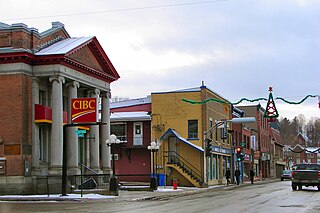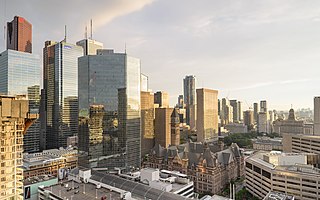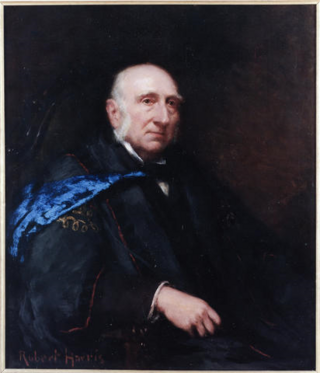
The Canadian Imperial Bank of Commerce is a Canadian multinational banking and financial services corporation headquartered at CIBC Square in the Financial District of Toronto, Ontario. The Canadian Imperial Bank of Commerce was formed through the 1961 merger of the Canadian Bank of Commerce and the Imperial Bank of Canada, in the largest merger between chartered banks in Canadian history. It is one of two "Big Five" banks founded in Toronto, the other being the Toronto-Dominion Bank.

The Bank of Nova Scotia, operating as Scotiabank, is a Canadian multinational banking and financial services company headquartered in Toronto, Ontario. One of Canada's Big Five banks, it is the third-largest Canadian bank by deposits and market capitalization. In 2023, the company’s seat in Forbes Global 2000 was 88. It serves more than 25 million customers around the world and offers a range of products and services including personal and commercial banking, wealth management, corporate and investment banking. With more than 89,000 employees and assets of CA$1,399 billion as of April 30, 2024, Scotiabank trades on the Toronto and New York exchanges. The Scotiabank swift code is NOSCCATT and the institution number is 002.

Bay Street is a major thoroughfare in Downtown Toronto, Ontario, Canada. It is the centre of Toronto's Financial District and is often used by metonymy to refer to Canada's financial services industry since succeeding Montreal's St. James Street in that role in the 1970s.
Big Five is the name colloquially given to the five largest banks that dominate the banking industry of Canada: Bank of Montreal (BMO), Scotiabank, Canadian Imperial Bank of Commerce (CIBC), Royal Bank of Canada (RBC), and Toronto-Dominion Bank (TD).

The Canadian Bank of Commerce was a Canadian bank that operated from 1867 to 1961. It merged in 1961 with the Imperial Bank of Canada to form the Canadian Imperial Bank of Commerce, which today is one of Canada's Big Five banks.

CIBC Tower is a 187 m (614 ft) 45-storey skyscraper in Montreal, Quebec, Canada. The International Style office tower was built by Peter Dickinson, with associate architects Ross, Fish, Duschenes and Barrett, and was the city's tallest building from 1962 to 1963. The building holds offices for the Canadian Imperial Bank of Commerce, the corporate law firm Stikeman Elliott, the Canadian accounting firm MNP LLP, as well as numerous other businesses.

Coaticook is a town on the Coaticook River, located in southeastern Quebec, Canada. It resides in the region of Estrie, which is often referred to colloqually as the Eastern Townships. It is the seat of the Coaticook Regional County Municipality, and its southern border is also the Canada–United States border.

Saint Jacques Street, or St. James Street, is a major street in Montreal, Quebec, Canada, running from Old Montreal westward to Lachine.

CIBC Caribbean is a financial services company based in Barbados and the Caribbean subsidiary of the Canadian Imperial Bank of Commerce (CIBC). The bank was founded in 2002 as FirstCaribbean International Bank through the merger of the Caribbean operations of Barclays Bank and CIBC, and in March 2006 both CIBC and Barclays announced that Barclays wished to exercise their option to exit the Caribbean venture completely resulting in CIBC gaining majority-control of the bank. In June 2011, it was announced the bank would be renamed CIBC FirstCaribbean Bank "to be more closely aligned to the CIBC brand, while still maintaining the FirstCaribbean name and local identity." The name was then later changed CIBC Caribbean in January 2024. The majority of the bank's revenues are generated by its operations in Barbados, the Bahamas and the Cayman Islands.

The Bank of Montreal's Head Office is located on 119, rue Saint Jacques in Montreal, Quebec, Canada, across the Place d'Armes from the Notre-Dame Basilica in the Old Montreal neighbourhood. The Bank of Montreal is the oldest bank in Canada, founded in 1817. Although it still remains the bank's legal headquarters, its operational head office was moved to First Canadian Place in Toronto in 1977 due to political instability in Quebec.

The Molson Bank Building was built at the corner of St. Peter and St. James streets in the Old Montreal neighbourhood of Montreal, Quebec as the headquarters of the Molson Bank in 1866 by order of founder William Molson (1793-1875). It was the first building in Montreal to be built in the Second Empire style, designed by George Browne working with his son John James George Browne.
The Canadian Imperial Bank of Commerce Building is a building at 265 Saint-Jacques Street in Montreal, Quebec, Canada.

The Bank of Hamilton was established in 1872 by local businessmen in the city of Hamilton, Ontario, Canada under the leadership of Donald McInnes, the bank's first President. Like the other Canadian chartered banks, it issued its own paper money. The bank issued notes from 1872 to 1922. The end dates are the final dates appearing on notes, which may have circulated for some time after.

The Financial District is the central business district of Downtown Toronto, Ontario, Canada. It was originally planned as New Town in 1796 as an extension of the Town of York. It is the main financial district in Toronto and is considered the heart of Canada's finance industry. It is bounded roughly by Queen Street West to the north, Yonge Street to the east, Front Street to the south, and University Avenue to the west, though many office towers in the downtown core have been and are being constructed outside this area, which will extend the general boundaries. Examples of this trend are the Telus Harbour, RBC Centre, and CIBC Square.
The Massawippi Valley Railway was a short line railway established in 1870 between Lennoxville, Quebec, and the Vermont border. Part of the Quebec Central Railway from 1926, the line was abandoned in 1990 and removed in 1992. Most of the former railway's right of way is now used for bicycle trails.
A routing number is the term for bank codes in Canada. Routing numbers consist of eight numerical digits with a dash between the fifth and sixth digit for paper financial documents encoded with magnetic ink character recognition and nine numerical digits without dashes for electronic funds transfers. Routing numbers are regulated by Payments Canada, formerly known as the Canadian Payments Association, to allow easy identification of the branch location and financial institution associated with an account.

Richard William Heneker is a Canadian businessman of Irish descent. Following his immigration to Canada in 1855, he settled in Sherbrooke, in Quebec. After a long career in business in Sherbrooke, he left Canada in 1902 to return to retirement in England.
The Eastern Townships Mounted Rifles was a cavalry regiment of the Non-Permanent Active Militia of the Canadian Militia. In 1936, the regiment was converted from cavalry to artillery and became the 27th Field Artillery Regiment, Royal Canadian Artillery.
The 7th Hussars was a light cavalry regiment of the Non-Permanent Active Militia of the Canadian Militia. First raised in 1867 as an infantry regiment in the Eastern Townships of Quebec, in 1903 the regiment was converted to cavalry. In 1936, the 7th Hussars were amalgamated with the 11th Hussars to form the 7th/11th Hussars.
The Sherbrooke Regiment was a regiment of the Canadian Militia and later the Canadian Army Reserve that existed from 1866 to 1965. Originally an infantry regiment, during the Second World War the regiment helped form the 27th Armoured Regiment (The Sherbrooke Fusilier Regiment) which served as an armoured (tank) unit in the 2nd Canadian Armoured Brigade. In 1946, the regiment itself was converted to an armoured regiment was redesignated as The Sherbrooke Regiment (RCAC). In 1965, the regiment was amalgamated with the 7th/11th Hussars to form The Sherbrooke Hussars.















